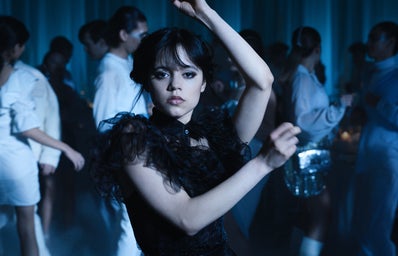Welcome ghosts and ghouls to the spookiest season of the year! In the twilight of October, as the world dons mysterious and experimental attire, there is no better time to delve into the depths of Goth fashion. Every day is Halloween, and every night is a chance to play with the shadows. The truth is, this season, we have the perfect excuse to explore the darkly glamorous world of Goth styles. With its roots in history, culture, and symbolism, Gothic fashion has transcended time and fashion trends. In 2023, designers such as Alexander McQueen, Versace, Rodarte, and Dior preview a resurgence of the iconic style and Gothic subcultures.
Unveiling the Style
We are traveling back to the Middle Ages when Gothic architecture transformed the European landscape between the 13th and 16th centuries. These ominous, intricate styles affected more than just buildings; they also influenced writers and poets to create eerie tales of ghosts and gloomy literature that expertly fused romanticism with horror. Artists from Germany and England blended a burning passion with a hopeless longing for a forbidden love or a life apart from their external, materialist society. Authors like Bram Stoker and Mary Shelley incorporated into their novels Goths’ favorite themes, such as crumbling castles, haunted mansions, vampires, and ghouls. Now widely acknowledged by musicians like The Cure, Joy Division, Bauhaus, and Siouxsie and the Banshees, these literary masterpieces inspired new musical genres.
During the Middle Ages, the Gothic style gained increasing prominence in both men’s and women’s fashion. It brought a sense of grandeur and drama to clothing, with flowing silhouettes and rich fabrics like velvet and brocade as popular choices. The Victorian era society became quite transparent about mortality and accepted darkness and death as ordinary parts of daily life. This shift in fashion reflected the Victorian era’s fascination with the macabre and its obsession with mourning rituals. Using somber colors and mourning attire allowed individuals to display their grief and honor the deceased, creating a visual language of sorrow and remembrance.
Cultural influences include ancient Egyptian powder known as kohl, used to create dramatic makeup still prevalent in the style today. Celtic and medieval influences accessorize an outfit with a symbolic presence that represents the complexities of the Gothic style as more than an aesthetic. As time went on, Gothic fashion became associated with supernatural and eerie elements, reflecting the themes found in Gothic literature and the haunting melodies of Gothic music.
Gothic Icons
Siouxsie Sioux, the lead singer of the influential band Siouxsie and the Banshees, embraced a unique and avant-garde style that became synonymous with Gothic fashion. Her striking black hairstyles, dramatic makeup, and bold fashion choices inspired countless individuals to embrace their dark side. Siouxsie’s contribution to Gothic culture extends beyond her music, as she continues to be an enduring symbol of individuality and rebellion in the goth community.
Theda Bara can be considered the pioneer of Gothic fashion, known as ‘America’s first Goth.’ Her style stepped outside traditional 1920s attire with her dark eye makeup, revealing yet mysterious clothing, and a general brooding appearance. She was the original Hollywood ‘vamp’ and created the vamp and femme fatale stereotypes we can recognize today. Bara’s portrayal of seductive and complex female characters in silent films, such as Cleopatra and Salome, captivated audiences. Her representation influenced other silent film actresses who embraced the ominous, pushing boundaries and challenging societal norms. Musidora, known for her role as Irma Vep in the French film series “Les Vampires,” exuded a seductive and enigmatic charm that left audiences enthralled. Similarly, Maila Nurm’s portrayal of Vampira in the 1950s established her status as a Gothic icon with her haunting beauty and spellbinding presence on screen. These women paved the way for future icons, including those with a popular family clap and oddballs who consider themselves one of the “strange and unusual.”
A Dark and Glamorous Evolution
Gothic fashion emerged in the early 1980s because of the fusion of Victorian romanticism with dark, rebellious punk aesthetics. One of the most misinterpreted fashion trends was born out of a stunning combination of architecture, language, music, history, philosophy, and culture. The reality of this style is far more nuanced than the popular portrayal, which features pale complexion, dark cosmetics, black apparel, and spikey accessories. Gothic fashion continues to make a powerful statement in the business, whether it is a protest to modern fashion, an attempt to embrace the supernatural, or the self-assurance to challenge conventional beauty.
The media’s infatuation with Gothic style in the middle of the 1990s gave rise to subgenres such as pastel goth, cyber goth, and Lolita goth. Goth fashion has been resurrected by contemporary stars like Taylor Momsen, Dove Cameron, Jenna Ortega, and figures like Lydia Deetz and Wednesday Addams, proving the style’s enduring popularity. When searching for a new style or a Halloween ensemble, consider the influences behind goth fashion to truly connect with its emotional depth and historical, cultural, and symbolic values.
A Glimpse into the Gothic Future
In recent years, the world has witnessed a spectacular resurgence of Gothic fashion, a style that defies conventional labels. Although some people associate this look with dark makeup, black nails, or unorthodox haircuts, Gothic fashion is nevertheless a compelling way of showcasing one’s individuality. This is a celebration of life and death, sometimes misinterpreted as ’emo,’ but has genuine connections to profound spiritual and philosophical concepts, ranging from social rebellion to French existentialism. Imaginative designers like Alexander McQueen, Versace, Rodarte, and Dior have given the mystical style new life.
Alexander McQueen: Reimagining the Dark Elegance
Known for pushing the envelope, Alexander McQueen’s S24 collection further redefines the gothic style. His runway debut expertly combines darkness and elegance with a contemporary touch to encapsulate the spirit of gothic fashion. Gothic fashion, as seen by McQueen’s works, is more than simply an outward manifestation; it celebrates the multiplicity of fashion as a statement of the individual and mirrors nature and abstract art.
Versace: The Goddess Gone Grunge
Often referred to as “Goddess gone grunge,” Versace’s most recent collection perfectly captures the mystical and philosophical aspects ingrained in Gothic design. In contrast to the vivid bright colors that adorned other 23/24 runways, Gothic fashion speaks to people’s anxiety about being judged but doesn’t shy away from creative expression. These designers use a rich combination of materials, carefully selected arrays of color, and expressive artwork to create one-of-a-kind items that confront that fear to embrace a unique identity.
Rodarte: Embracing the Gothic Fairy Tale
We embark on a Gothic fairy tale journey with Rodarte’s Gothic Fairy Collection for FW23/24. Gothic fashion is more than simply a style; it’s a gateway to a mysterious and enchanting world, as seen by its intricate details and hauntingly ethereal patterns. This collection pays homage to the rich heritage of Gothic fashion while reviving its essence for the modern day.
Dior: A Contemporary Take on Gothic Aesthetics
Dior’s S24 collection is a testament to how Gothic fashion evolves while preserving its essence. The juxtaposition of contemporary design with classic Gothic motifs demonstrates the enduring appeal of this style. It is a reminder of how Gothic fashion is a bridge between the past and the future, allowing us to explore the darker corners of our imagination.
Gothic fashion is a triumphant comeback to the catwalk, reminding us it symbolizes the human condition, our insatiable pursuit of beauty in the macabre, and our fascination with darkness and mortality. So next time you embrace the dark elegance of Gothic fashion, remember that it’s not just a style; it’s a journey into the depths of our souls.


